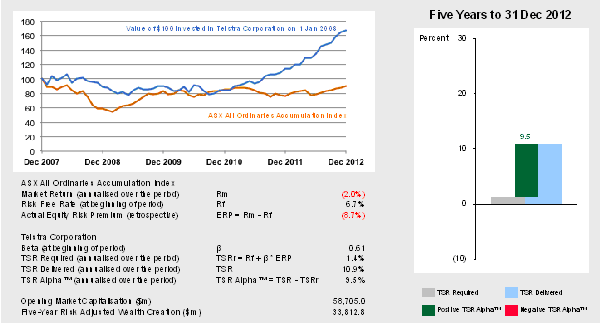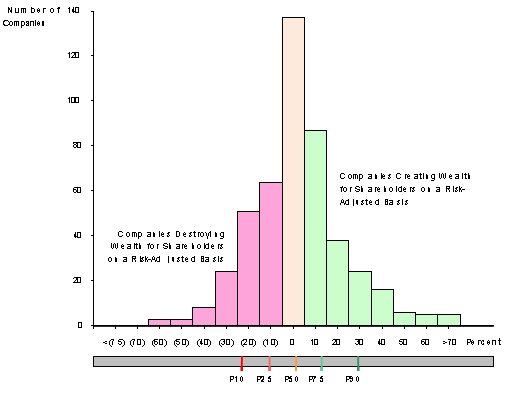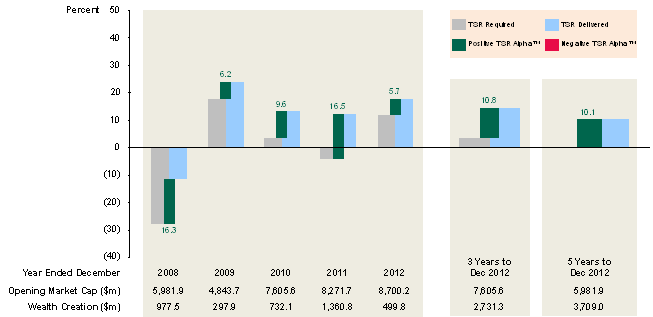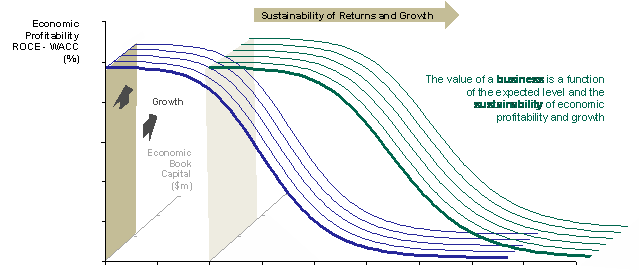Most CEOs, CFOs and Remuneration Committee Chairs know just how hard it is to link TSR (and particularly Relative TSR) with internal accounting measures like EBIT and ROCE – making it difficult to link what executives believe are value-creating actions taken internally, with actual changes in market value. This “disconnect” can lead to lottery-like outcomes from LTI plans – a situation that is unsatisfactory for shareholders, non-executive directors and executives alike.
At least part of the solution to LTI design, as well as the ability to get alignment between LTI and STI plans, is to use TSR Alpha™ as an external measure with Economic Profitability as the internal one.
Defining TSR Alpha™
TSR Alpha™ is the difference between the TSR Delivered by a company over a specified measurement period and the TSR Required by its shareholders in order to preserve the value of their investment and it excludes the factors that make Relative TSR so difficult to track, such as market sentiment and market movements not driven by company performance.
TSR Delivered, TSR Required and TSR Alpha™ can all be calculated easily from market information at the end of any measurement period. Figure 1 illustrates the calculation for Telstra Corporation for the past five years.
Figure 1. Calculation of TSR Alpha™ for Telstra Corporation for the five years to 31 December 2012
TSR Alpha™ Outcomes for the ASX
The distribution of annualised TSR Alpha™ for the ASX is illustrated in Figure 2. Companies that created shareholder wealth by outperforming market expectations are in the green zone. Companies that underperformed market expectations and destroyed shareholder wealth are in the red zone.
Figure 2. Distribution of five-year TSR Alpha™ performance for the top 500 ASX-listed companies
It is difficult to get into the green zone. But it’s even more difficult to stay there. Continually delivering a positive TSR Alpha™ means continually delivering performance in excess of expectations, (which are themselves continually increasing). Nevertheless eleven companies in the ASX 300 delivered a positive TSR Alpha™ every single year from 2008 to 2012. Their performance is illustrated in Figure 3. The shaded companies are from the ASX 100.
Figure 3. Consistent outperformers in the ASX 300
Almost regardless of when an investor bought shares in one of these companies over the last five years, their investment would have been wealth creating – and in most cases significantly so. That’s important because not everyone holds shares for the full three-year or five-year period on which most performance scorecards are based.
Figure 4 details the performance of one of these companies – Amcor Limited.
Figure 4. Amcor TSR Alpha™ performance over the five years to 31 December 2012
It’s also difficult to continually deliver a negative TSR Alpha™. Companies that under perform market expectations will end up in the red zone of the distribution shown in Figure 2. But they should only stay there for a relatively short time. This is because if they deliver the financial performance consistent with the new and lower financial performance expectations that got them there in the first place, they will revert to a TSR Alpha™ of zero. So remaining in the red zone for an extended period is a sign of serious underperformance.
Seven companies in the ASX 300 produced a negative TSR Alpha™ every year from 2008 to 2012. Their performance is summarised in Figure 5. Once again, the shaded companies are in the ASX 100.
Figure 5. Consistent underperformers in the ASX 300
Why you should consider adopting TSR Alpha™
Like TSR and Relative TSR, TSR Alpha™ is a retrospective measure. However unlike TSR and Relative TSR, the success of a company in continually delivering a positive TSR Alpha™ says a lot about the quality and the capability of its leadership team.
At the same time, it is impossible to link changes in internal performance measures like EBIT and ROCE with changes in TSR – let alone with changes in Relative TSR. But it’s easy to link Economic Profitability with TSR Alpha™. How this is done is outlined in a paper entitled Linking Economic Profit and TSR Alpha™.
The understanding developed in calculating TSR Alpha™ also enables us to take a forward-looking perspective and set wealth creation goals in terms of future TSR Alpha™ outcomes (5% p.a. is good, 10% p.a. is excellent).
Such goals are not only completely independent of future movements in the market as a whole, but are able to be expressed in terms of a bow wave of future economic profits that must be delivered in order to justify the current share price, and exceeded in order to create wealth. The nature of this bow wave is illustrated in Figure 6.
The bow wave can be unpacked into the three fundamental drivers of value that management can control – namely returns, growth and the sustainability of both. Most companies work assiduously with the first two but don’t focus so much on the third (perhaps because it lies beyond the tenure of the current leadership team).
KBA’s analysis shows that those companies that consistently deliver a positive TSR Alpha™ tend to have much longer bow waves (30-40 years) than those that don’t (10-15 years). This suggests that the market may be valuing the capabilities established within companies like Amcor (35-year bow wave) and Super Retail Group (30-year bow wave) that enable both its current leadership team, and that team’s likely successors, to continually develop and implement new and higher value strategies.
Figure 6. The three primary drivers of value – returns, growth and the sustainability of both
Most would agree that the legacy of good leadership is an institution that not only outlives the tenure of its current leaders, but which prospers well into the future through the individual and organisational capabilities established during their tenure.
It is comforting to know that such leadership appears to attract a significant market premium in the ASX.
TSR Alpha™ was developed by KB Consulting Group, you can find out more by clicking here.






